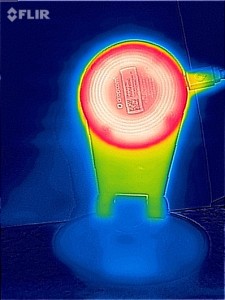
We tore down the Dropcam Pro camera for thermal analysis. The camera reveals a simple but clever thermal design that uses an aluminum rear-housing treated with soft touch paint to reduce perception of heat when touched. There is a dedicated heat sink for the image processor and a graphite sheet reinforced with cooper to dissipate heat from the LEDs.
The camera can get hot depending on the configuration settings and ambient temperature conditions. In our testing, the camera got hot but remained operational when tested at room temperature (∼23ºC) with the Night Vision setting active for more than 2 hrs. Touching the rear-cover feels slightly annoying and some users might complain in blogs and reviews. The maximum temperature measured with the IR camera was 46°C at the back housing.
LEDs board: The LEDs are connected to a plastic housing, possibly a high conductivity plastic (e.g., Coolpoly). The LED-housing is then connected to an Al-heat sink (HS1 from now on) using a graphite sheet reinforced with cooper (e.g., EGRAF). Cooper provides structural strength to the graphite sheet.
Image sensor board: The image sensor is mounted to the PCB and thermal vias are used to transfer heat efficiently to HS1. A thermal pad is used between HS1 and the PCB. This heat sink is shared with the LEDs and DSP. Maybe not a very good idea (more on this later).
Main board: The DSP is mounted to the PCB and thermal vias are used. The vias are then connected to the Al-back housing (heat sink) with thermal pads. Protrusions from the rear cover help to reduce the thermal resistance from the thermal pads. The top side of the DSP (or case) is also attached to HS1. Great use or resources, but not very efficient for thermals.
The good: There are dedicated heat sinks for all the major components (i.e., DSP, image sensor, DDR, WiFi, flash). The back housing doubles as a heat sink. The protrusions help to reduce the thermal resistance from components to heat sink.
The bad: As we all know, heat transfers from hot to cold temperatures. The internal heat sink is thermally attached to the image sensor, DSP and LEDs. Connecting all components to the same heat sink will chock the temperature gradient and reduce the potential. Besides, as different components have different thermal limits, this can create a situation where some components are overheating due to strong thermal-influences from nearby components.
The ugly: Graphite is widely used in tablets and smartphones. Graphite has a high in-plane conductivity (>300 Wm-¹K-¹) and a relatively low through-plane conductivity (<4 Wm-¹K-¹). Thus, it is ideal for small devices as it spreads heat quickly but works as a thermal shield (protecting the housing) as well. The need for this particular application is not clear in this case and even with the reinforced cooper the graphite sheet seems to be vulnerable and breaks easily (maybe a good thing).
Please check the pictures and descriptions for more clarity on the thermal design.




 (1 votes, average: 5.00 out of 5)
(1 votes, average: 5.00 out of 5)
